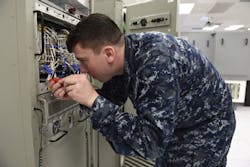WASHINGTON — U.S. Navy surface warfare experts are ordering additional advanced shipboard electronic warfare (EW) systems for surface warships like aircraft carriers, amphibious assault ships, cruisers, and destroyers under terms of a $119.6 million order.
Lockheed Martin is providing the Navy with SEWIP shipboard electronic warfare systems.
Officials of the Naval Sea Systems Command in Washington are exercising options with the Lockheed Martin Corp. Rotary and Mission Systems segment in Liverpool, N.Y., for full-rate production of AN/SLQ-32(V)6 Surface Electronic Warfare Improvement Program (SEWIP) Block 2 subsystems.
SEWIP Block 2 is an evolutionary acquisition and incremental development program to upgrade the existing AN/SLQ-32(V) electronic warfare system.
SEWIP provides enhanced shipboard EW for early detection, analysis, threat warning, and protection from anti-ship missiles. SEWIP Block 2 will enhance the shipboard EW system’s receiver and antenna group to meet the latest threats.
SEWIP Block 2 expands on the receiver and antenna group necessary to keep capabilities current with the pace of the threat and to yield improved system integration, Navy officials say.
Lockheed Martin won a $98.5 million order in March 2017 for full-rate production of AN/SLQ-32(V)6 SEWIP Block 2 subsystems. In October 2017, the company won a $148.9 million contract AN/SLQ-32A(V)6) and AN/SLQ-32C(V)6 SEWIP shipboard EW systems. Before that, Lockheed Martin won a Navy award for SEWIP Block 2 in late 2009, leading a team of ITT Electronic Systems (now Harris Corp.), Cobham Defence Electronic Systems, Research Associates Syracuse, and Azure Summit Technology of Fairfax, Va.
The Lockheed Martin Block 2 SEWIP design is based on its integrated common electronics warfare system (ICEWS), which enables rapid reconfiguring of the system with commercial technology.
Mercury Systems in Andover, Mass., is providing advanced radio frequency microwave tuners and intermediate frequency products for SEWIP Block 2. Lockheed Martin chose the Mercury Echotek series microwave tuner and digital receiver, which are optimized for fast tuning and high performance.
Lockheed Martin will do the work in Liverpool, Frankfort, and Hauppauge, N.Y.; Lansdale and Lancaster, Pa.; Andover and Brockton, Mass.; Hamilton, N.J.; West Yorkshire, England; Minneapolis; and Huntsville, Ala., and will be finished by December 2019.
For more information, visit Lockheed Martin online at www.lockheedmartin.com/us/rms.

